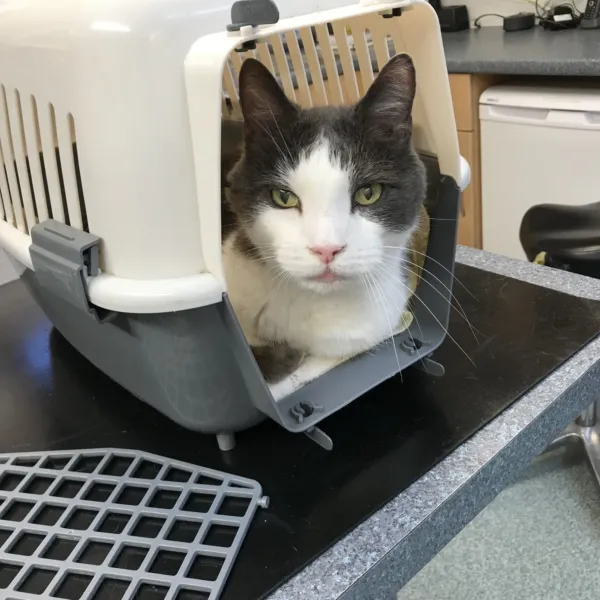Transporting Your Cat
Cats need to be in control of their surroundings and are sensitive to different stimuli, including smells. The following information will help you make their visits to and from the practice less stressful...
Bringing your cat to the practice
All cats MUST be brought to the practice in a secure cat carrier. They should not be taken out of their carrier when in the waiting room.
Choose a good carrier for your cat:
- It should be robust and easy to clean (plastic or plastic-coated)
- Avoid cardboard disposable carriers, they are not secure and are no use if wet
- Top-opening carriers are easier – the cat can be gently lifted in or out
- Put newspaper and a towel in the carrier, in case your cat urinates
- Cover the carrier with a blanket or towel during the journey to keep the cat calm
- Secure the carrier in the car in a footwell or seat so it cannot move
- Hold the carrier carefully – avoid swinging it or banging it against objects
Familiar smells cat help reduce your cat's stress:
- Use the carrier at home – encourage your cat to sleep or be fed in the carrier, so it does not only appear when there is a vet visit!
- Put bedding or clothing that smells of home in the carrier
- Rub a cloth around the cat’s face to pick up a scent, then rub this around the carrier and leave it inside
- Spray the carrier with Feliway® (if available), 30 minutes before using it. Feliway can be purchased here at the practice.
- If your cat panics, wrap him/her in a thick blanket and put both in the carrier
- Take spare bedding (smelling of home) in case the cat soils the carrier
You may find the following leaflet useful - 'Getting Your Cat to the Veterinarian', click here.
Taking Your Cat Back Home from the Practice:
When it's your cat's turn to go home, they must leave the consulting room in their carrier. This should be secured in the normal way. Do not open the carrier until you get your cat back in the safety of your home.
Going Home:
After a stay at the practice, you may need to take special care of your cat when they get back home.
If your cat has had an anaesthetic that day, they may:
- Your cat may still be subdued and a little unsteady on its feet
- Cats may be nervous and disorientated – talk and stroke them gently, allowing them to initiate closer contact when they are ready
- Try to prevent your cat licking any wound or pulling at any stitches. If this happens, ask your vet about a soft collar your cat can wear temporarily
- Call the clinic if you have any concerns such as the wound looking red or swollen, a discharge, or if you feel that your cat is not recovering well
- Make sure any medications are given
- Pain can be difficult to recognise in cats but signs include loss of appetite, hiding or being withdrawn
- Contact the clinic if you have any concerns
- You may need to keep your cat indoors, for the first night or longer
- Provide a quiet, warm spot in the house for your cat to rest
Re-introduction to other cats at home:
Your cat may have picked up unfamiliar scents while at the clinic, especially after an overnight stay or longer. These smells may make other cats at home anxious so it is best to re-introduce the cats gently:
- Make sure you are present to supervise when the cats are re-introduced
- Don’t overwhelm the returning cat with attention from people or pets
- Allow your cat to pick up the smells of home before mixing with other cats
- If needed, keep cats separate for 1-2 days allowing gradual contact
- Wash any bedding you bring back to remove smells of the practice
- Mix the cats’ scents - stroke each in turn - particularly around the head, and perhaps exchange their bedding
- Your cat’s favourite resting places can be sprayed with Feliway Classic® (synthetic cat pheromone)
For further information please read the leaflets entitled Bringing your Cat to the Clinic and Taking your Cat Home from the Clinic, written by International Cat Care.
To visit their website click here.



